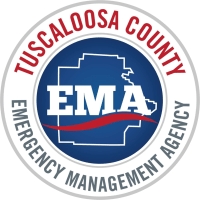
Every disaster is different, and there are many steps that people should always take to stay safe – and staying informed is one of them. Most people don’t think about planning for a disaster until it’s too late. TuscALERT can prevent this from happening. These alerts ensure that friends and family aren’t left in the dark during weather-related emergencies or other disasters.
TuscALERT allows Tuscaloosa County residents and businesses to be notified of weather-related emergency situations and other important community messages. Alerts may be received in a variety of ways, such as calls on cell phones, home, and work phones, by text messaging, and by e-mail - it's your choice. This free service runs through the Everbridge mass notification platform and is managed locally by Tuscaloosa County EMA.
In order to receive alerts, you must provide your contact information and subscribe to customized notifications based on your location. Your information is protected and will never be sold to any third party. If you would like to receive up-to-date alerts, sign up today!
Alert Types
Wireless Emergency Alerts (by phone)
During an emergency, alert, and warning officials need to provide the public with life-saving information quickly. Wireless Emergency Alerts (WEAs), made available through the Integrated Public Alert and Warning System (IPAWS) infrastructure, are just one of the ways public safety officials can quickly and effectively alert and warn the public about serious emergencies.
What you need to know about WEAs:
- WEAs can be sent by state and local public safety officials, the National Weather Service, the National Center for Missing and Exploited Children, and the President of the United States.
- WEAs can be issued for three alert categories – Imminent Threat, AMBER, and Presidential.
- WEAs look like text messages, but are designed to get your attention and alert you with a unique sound and vibration, both repeated twice.
- WEAs may be comprised of no more than 90 characters, or as many as 360 characters (depending on the make/model of the phone), and will describe the nature and location of the threat or emergency, any action you should take, as well as the agency issuing the alert.
- WEAs are not affected by network congestion and will not disrupt texts, calls, or data sessions that are in progress.
- Mobile users are not charged for receiving WEAs and there is no need to subscribe.
- To ensure your device is WEA-capable, check with your wireless service provider.
Emergency Alert System (by radio, TV, and other systems)
- The Integrated Public Alert and Warning System (IPAWS), is a modernization and integration of the nation's existing and future alert and warning systems, technologies, and infrastructure.
- The Emergency Alert System (EAS) is a national public warning system that requires broadcasters, satellite digital audio service and direct broadcast satellite providers, cable television systems, and wireless cable systems to provide the President with a communications capability to address the American people within 10 minutes during a national emergency.
- EAS may also be used by state and local authorities, in cooperation with the broadcast community, to deliver important emergency information, such as weather information, imminent threats, AMBER alerts, and local incident information targeted to specific areas.
- The President has sole responsibility for determining when the national-level EAS will be activated. FEMA is responsible for national-level EAS tests and exercises.
- EAS is also used when all other means of alerting the public are unavailable, providing an added layer of resiliency to the suite of available emergency communication tools.
NOAA Weather Radio (by NOAA Radio)
NOAA Weather Radio All Hazards (NWR) is a nationwide network of radio stations broadcasting continuous weather information from the nearest National Weather Service office.
- NWR broadcasts official warnings, watches, forecasts, and other hazard information 24 hours a day, 7 days a week.
- It also broadcasts alerts of non-weather emergencies such as national security, natural, environmental, and public safety through the Emergency Alert System.

